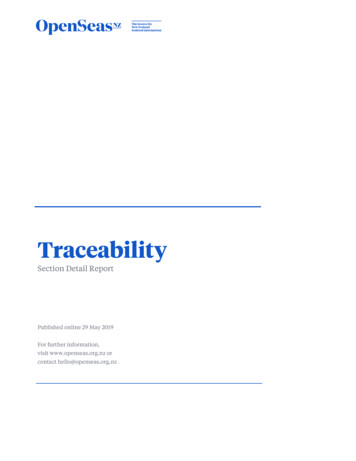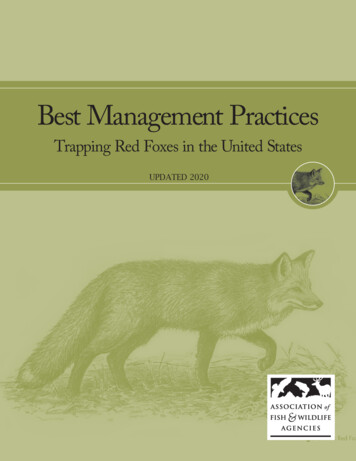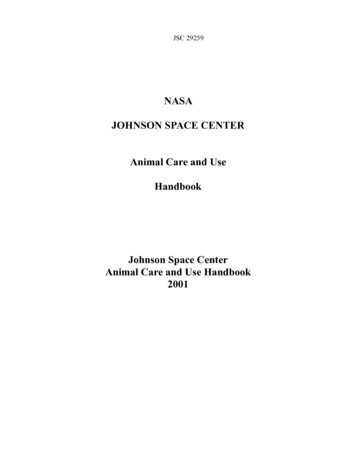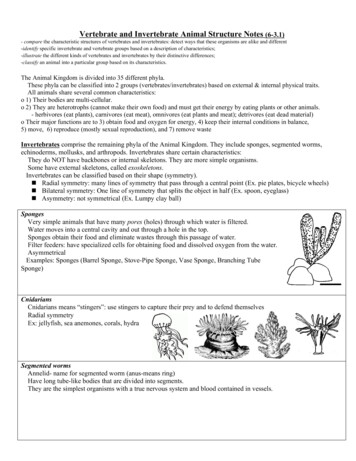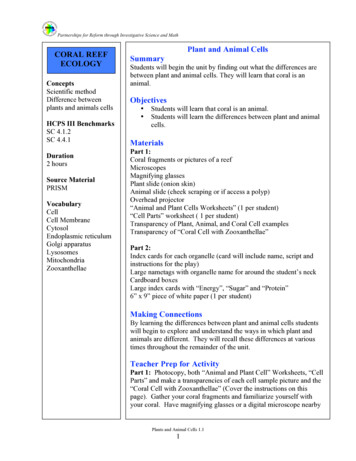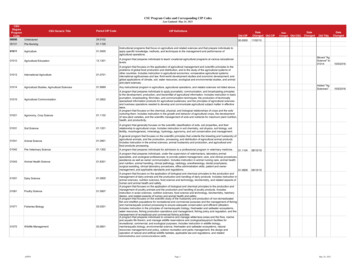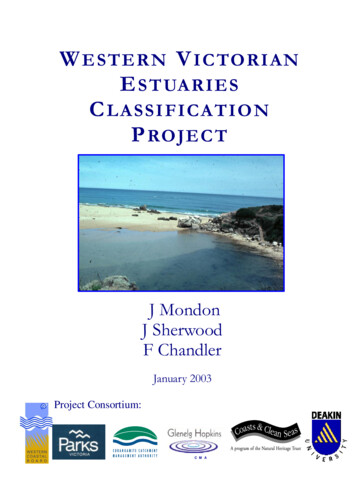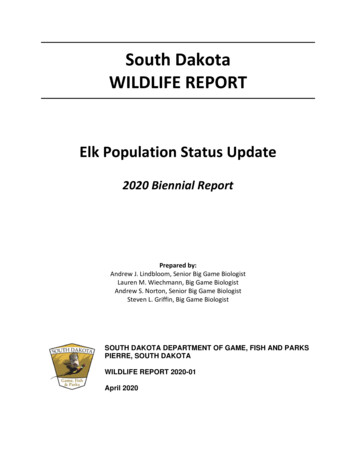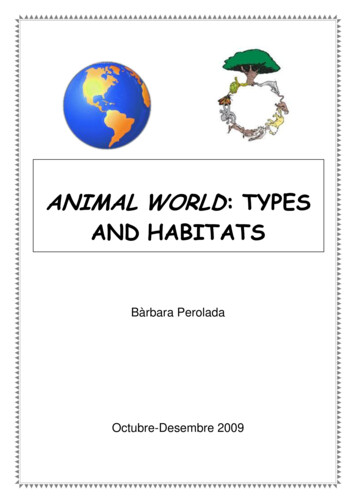
Transcription
ANIMAL WORLD: TYPESAND HABITATSBàrbara PeroladaOctubre-Desembre 2009
ANIMAL WORLD: TYPES AND HABITATSName: Date:Worksheet 11.- Complete this Venn Diagram. Put the sentences into the box below.They grow.They can move from one place to another.They can not move. They eat. They use the sunlight to make their food.They have roots in the ground.They reproduce.They die.They eat. They eat other living things.They are born.Write the differences between plants and animals: Bàrbara PeroladaEscola Carles III
ANIMAL WORLD: TYPES AND HABITATSName: Date:Worksheet 21. Fill in the gaps: are animals with backbone. Invertebrates are animals .2. Complete the mind map:INVERTEBRATESBàrbara PeroladaEscola Carles III
ANIMAL WORLD: TYPES AND HABITATSName: Date:Worksheet 3Animal PassportName:Group it belongs to:It belongs to thegroup.Appearance. What is the body like?Habitat. Where does it live?How does it live? How does it move?LANGUAGE SUPPORTAppearance: It’s / It’s got /It hasn’t got Habitat: It lives / It’saquaticterrestrialHow does it live?: It can /It can’t Bàrbara PeroladaEscola Carles III
ANIMAL WORLD: TYPES AND HABITATSWorksheet 4Name: Date:1. Complete this table by tickling the correct boxes.FishAmphibiansReptilesMammalsBirdsThey change their appearance.They have a head, a trunk and limbs.They have a tail.They have scales.They have feathers.They have fur or hair.They breathe through gills.They breathe through lungs.They lay eggs.They give birth to live young.2. Create your own vertebrate and describe it.LANGUAGE SUPPORTThis is a ./It’s a It’s got/It hasn’t got It lives It can ./ It can’t Bàrbara Peroladabreathelaygive birthEscola Carles III
ANIMAL WORLD: TYPES AND HABITATSName: Date:Worksheet 5Learn a little bit more about GFACTSIZEBàrbara PeroladaEscola Carles III
ANIMAL WORLD: TYPES AND HABITATSName: Date:Worksheet 61. What do you do to cope with different situations? What do aquatic birds do?to protect you from the rainto protect you from the sunto protect you from the coldto make a bedto pick up small objectsto deal with the darkto greet friendsuseput onlook forI/Aquatic birdsme. to protectfromthemthe rainthe sunthe coldturn on to make a bed.have to pick up small objects.send to deal with the dark.makeproduce to greet friends.takeBàrbara PeroladaEscola Carles III
ANIMAL WORLD: TYPES AND HABITATSName: Date:Worksheet 71. Complete this diagram with the words in the box below:I’madiverI’madabblerfeeds at the bottom.rounded bodysloping down tailraised taillegs centrally under the bodyelongated bodyfeeds on the surfacelegs back on the body2. Who is “the diver” and who is “the dabbler” in the aquatic bird’s world?Bàrbara PeroladaI’ve got a rounded shape, soI’m a .I’ve got my legsthe body, so I’m a diver.I feed (eat) on the surface, soI’m a .I’ve got atail, so I am a dabbler.I’ve got an elongated body, soI’m a .I feed soI’m a diver.I’ve got a sloping down tail, soI am a .I’ve got my legs back on thebody, so I’m a .Escola Carles III
ANIMAL WORLD: TYPES AND HABITATSName: Date:Worksheet 81. What sort of food can aquatic birds get according to the way they move? Work in pairs andmake up a menu taking into account these facts:PotamogetonSpecies floats on thesurface of waterCarps swim underwaterFrogs stay on thesurfaceWater fleas swim underthe waterFreshwater snailsgo along the bottomPotamogeton species growat the bottomCrayfish stays on thesurfaceNon-biting midges hideat the bottomWater rats swim on thesurfaceGammarus swim underwaterWater lentils float on thesurfaceViperine snakes swimon the surfaceABLet’s take the What about as astarter ?Why don’t we take . asa ?Bàrbara PeroladaYes, ok!!No, let’s take the What about as a ?Why don’t we take asa ?Escola Carles III
ANIMAL WORLD: TYPES AND HABITATSName: Date:Worksheet 9STARTERSMAIN COURSEDESSERTSThank you for coming!!!Bàrbara PeroladaEscola Carles III
ANIMAL WORLD: TYPES AND HABITATSName: Date:Worksheet 10AT THE RESTAURANT (Role-play)W: Good morningAB1: Good morningW: Can I help you?AB2: Yes, please. Can I have the menu, please?W: Here you are.AB1: Thank you.W: What’s for lunch?dinner?AB2: Can I have . as a startermain course please?dessertAB1: Can I have for me, please?W: Enjoy your meal!AB1&2: Thank you!AB1: Can we have the bill, please?W: Here you are. Thank you for comingAB1&2: Very nice, thank you, bye!!!W: Bye!Bàrbara PeroladaEscola Carles III
ANIMAL WORLD: TYPES AND HABITATSName: Date:Worksheet 111. What do you think aquatic birds’ feet look like? Draw and answer the questions.Are they big, small, wide, narrow?How many toes have they got?What can they do with them?2. After learning about feet, draw and describe the different types of feet and label the parts.12341. They are .They have got .Aquatic birds can with them.2.3.4.Bàrbara PeroladaEscola Carles III
ANIMAL WORLD: TYPES AND HABITATSName: Date:Worksheet 12Let’s investigate!!What do we want to find out?What do we need?Bàrbara PeroladaEscola Carles III
ANIMAL WORLD: TYPES AND HABITATSWhat do we do?1. Put some droplets on the feather with the help of a dropper.2. Observe the feather in the microscope.3. Record your results.What do we think will happen? Droplets roll down the feather and fall to the floor Droplets soak into the feather and disappear. Droplets stay on the feather. Droplets take a rounded shapeBàrbara PeroladaEscola Carles III
ANIMAL WORLD: TYPES AND HABITATSWhat happened? Droplets roll down the feather and fall to the floor Droplets soak into the feather and disappear. Droplets stay on the feather. Droplets take a rounded shapeWhat have I learned?Why?Bàrbara PeroladaEscola Carles III
ANIMAL WORLD: TYPES AND HABITATSName:Date:Worksheet 131. Complete the tableBàrbara PeroladaEscola Carles III
ANIMAL WORLD: TYPES AND HABITATSName: Date:Worksheet 141. Create your own aquatic bird.Language supportlegstailThebeakare / is feetBàrbara PeroladaEscola Carles III
ANIMAL WORLD: TYPES AND HABITATSWorksheet 15Name: Date:ShapeHave you got ?roundedelongatedLegsshortback under the bodycentrally under the bodylongTaillongshortraisedsloping downBeaklongshortthickthinFeetclawedBàrbara Peroladathin and longwebbedEscola Carles III
ANIMAL WORLD: TYPES AND HABITATSName: Date:Questions to answer:1. What do you do to cope with different situations? (See worksheet 6)2. Where do you eat (feed)?on the surfacediverso I’m aI eatat the bottomdabbler3. What can you do?flyI can / I can’tswimdivedabble4. How can you communicate with the other aquatic birds? (See worksheet 13)5. Ask your partner and write his/her answers.My friend’s aquatic bird!Bàrbara PeroladaEscola Carles III
ANIMAL WORLD: TYPES AND HABITATSName: Date:Worksheet 161. Complete the chart using the information you remember about habitats.HabitatBàrbara PeroladaTemperature/weatherMain animalsEscola Carles IIIVegetation
ANIMAL WORLD: TYPES AND HABITATSName: Date:Worksheet 17Cut out these speech bubblesI can go for along timewithout water.I love meat andwarm places.I’ve got fins forswimming and gillsto breathe underwater.My white fur isthick and warm tokeep me insulated.I like flying from onetree to another. I canfind seeds aroundthem because it rainsa lot.I’ve got horns on my head.I eat grass and ferns.Bàrbara PeroladaEscola Carles III
ANIMAL WORLD: TYPES AND HABITATSName: Date:Worksheet 181. Guess the animals and habitats. Stick the bubbles onto the right animal and draw lines tomatch the animals with their habitat.There are many different types oftrees. It’s not very hot or verycold.Animals always get fresh grass toeat because grass is everywhere.It rains a lot so it provides idealconditions for a lot of animalsand plants.It doesn’t rain a lot so not a lot ofanimals live there.The winters are so long and dark.It’s very cold and it snows a lot.It’s the biggest habitat in theworld. Animals need specialadaptations to live there.Bàrbara PeroladaEscola Carles III
ANIMAL WORLD: TYPES AND HABITATSWorksheet 19Name: Date:They normally eat fish.During the day it is very hotand during the night it is verycold.Our habitat is the desert.Some animals feed on insects and someon plants.Camels, snakes, insects, spiders are the mostcommon animals.Camels don’t need a lot of waterto survive.Our habitat is the grassland.Some of them have gills to breatheunder the water and fins to swim.They like living there because the skinkeeps them warm.Lions, zebras, elephants, antelope,buffalos are the most common animals.It’s got dry and rainy seasons.Polar bears, reindeers, seals are the mostcommon animals.They like it because there are a lot ofdifferent plants and places to live.Our habitat is the forest.Our habitat is the ocean.Rabbits, foxes, squirrels, bears, deer andbirds are the most common animals.Most of them like grass to eat exceptlions because they eat meat.Crocodiles, monkeys, parrots, snakes are the most common animals.Animals like warm placesIt is very cold and the winter is very longand dark.Camels store fat in their humps (food) andsnakes eat other animals.Fish, whales, sharks and someinvertebrates live in the ocean.Bàrbara PeroladaOur habitat is the Arctic.On the surface it is warm but atthe bottom it is very cold.It rains almost every day.It provides places to live and protection to a lot ofanimals.Some of them eat plankton and others small sea creatures.Our habitat is the rainforest.In the rainforest, some animals eat others animals and others eat plantsand also fruitsEscola Carles III
ANIMAL WORLD: TYPES AND HABITATSName: Date:Worksheet 191. Complete the boxes with the information you have read.DesertGrasslandRainforestBàrbara PeroladaEscola Carles III
ANIMAL WORLD: TYPES AND HABITATSOceanArcticForestBàrbara PeroladaEscola Carles III
ANIMAL WORLD: TYPES AND HABITATSWorksheet 20Name: Date1. Make sentences and write them in the right place.SPRINGSUMMERAUTUMNWINTERBàrbara PeroladaEscola Carles III
ANIMAL WORLD: TYPES AND HABITATSLANGUAGE sheet 21begin to grow.start their life cycle.continue growingcontinue growingprepare to hibernate.have no leaves.save their energy for the warmer weather.LANGUAGE SUPPORT – Activity HOT SEATHave you gotBàrbara Peroladabackbone?less than six legs?eight legs?wings?an elongated body?a shell?Can youAre youEscola Carles IIIfly and swim?swim?an amphibian?
ANIMAL WORLD: TYPES AND HABITATSName: Date:1. Complete the life cycle of a frog.Bàrbara PeroladaEscola Carles IIIWorksheet 22
ANIMAL WORLD: TYPES AND HABITATSName: Date:Worksheet 231. Dictate the text to your partner and write the missing words.Life cycle of a frog (A)Frogs are . They spend their lives part in the water and part on the .Frogs lay their in a pond. The eggs hatch into (baby frogs). Tadpoles live inthe . A tadpole has a and no legs and with gills. It eatsfrom the water. It grows back legs and legs. It loses its tail and its. Now it looks like a very frog: froglet. It can live on the land and swim inthe . The frogs breathe with lungs and insects. Now it’s an frogand it can lay .Bàrbara PeroladaEscola Carles III
ANIMAL WORLD: TYPES AND HABITATSName: Date:Worksheet 231. Dictate the text to your partner and write the missing words.Life cycle of a frog (B)are amphibians. They spend their lives part in the and part on the land. Frogstheir eggs in a pond. The hatch into tadpoles (baby frogs). livein the water. A tadpole has a tail and no and breathes with . It eats plants fromthe . It grows legs and front legs. It loses its and its gills. Now itlooks like a very small frog: . It can live on the and swim in the water. Thefrogs with lungs and eat insects. Now it’s an adult frog and it can eggs.Bàrbara PeroladaEscola Carles III
ANIMAL WORLD: TYPES AND HABITATSWorksheet 24Name: Date:1. Use the key to identify the animals below.Has this animal gotbackbone?YesNoCan it fly and swim?Has it got legs?YesNoHas it got less than 6 legs?Has it got a shell?NoYesduckIs it an amphibian?NoYesNoYesNoHas it got an elongatedbody?Does it have wings?YesHas it got 8 legs?fro gfishYesYestadpoleflatwormpo nd skaterBàrbara PeroladaNoNodragonflypo ndsnailYeswater spiderEscola Carles III
ANIMAL WORLD: TYPES AND HABITATSWorksheet 25PassporttopondworldName:Date:Season:Bàrbara PeroladaEscola Carles III
ANIMAL WORLD: TYPES AND HABITATSMy pond creature is called aMy pond creature looks like this:Bàrbara PeroladaEscola Carles III
ANIMAL WORLD: TYPES AND HABITATSDetails about my pond creature:Number of legsColourShape (body)SizeHow does itmove?What does it eat?Where does itlive?Bàrbara PeroladaEscola Carles III
ANIMAL WORLD: TYPES AND HABITATSHow does the pond look like inthis season?Bàrbara PeroladaEscola Carles III
ANIMAL WORLD: TYPES AND HABITATSAssessment Unit 1: Living things: AnimalsW.26Name: Date: Group:1. Write the differences between plants and animals. Use the sentences in the box.They grow.They can move from one place to another.They can not move. They eat. They use the sunlight to make their food.They have roots in the ground.They reproduce.They die.They eat. They eat other living things.They are born.AnimalsPlants2. Write the name of these animals in the correct place.VertebratesInvertebratesWhich group do they belong to?-The belongs to the group.The belongs to the group.group.Bàrbara PeroladaEscola Carles III
ANIMAL WORLD: TYPES AND HABITATS3. Complete the chart with six examples:INVERTEBRATESAquaticTerrestrial4. Use the pictures bellow to solve these clues to find out who is who. Create yours.I am a cold-blooded.I lay eggs.I have scales.I have 4 legs and a tail.I am warm-blooded.I have a beak.I have feathers.I breathe through my lungs.I am symmetrical.I am covered by a thin skin.I have spines.I live in the sea.I am aI am aI am aI am warm-blooded.I am terrestrial.I have fur.I am viviparous.I have a shell.I live in the ocean.I have claws to eat.I have an abdomen.I am aI am a5. Complete this text with the words in the box.backbone (2) - snail- spines- fish- jellyfish- legs- coral-slug- gills- scales- cellsAnimals can be divided into two groups: animals with and without.Sponges consist of Two examples of cnidarians are:and . Worms have no and the starfish has got arms or .Some molluscs live on land such as and . Crocodiles have theirbody covered with like the . These have also for breathing.Bàrbara PeroladaEscola Carles III
ANIMAL WORLD: TYPES AND HABITATSAssessment Unit 3: Habitats: The pondName: Date. Group: W.271.Choose the correct words and write them in the spaces in the sentences.1. A is a place where it is very hot.desert/river2. The water in the ocean is .hot/salty3. Arctic is a very place.hot/cold4. A forest will have plenty of strong .trees/grass5. Grasslands usually have a lot of .grass/water6. In the rainforest it almost every day.rains/snows7. Whales and dolphins breathe air but live in the .oceans/Arctic2.Complete each sentence with the correct ending, A-GIn Spring Animals in the pond A. have no leaves.Plants B. prepare to hibernate.In Summer The pond C. save their energy for the warmer weather.In Autumn The weather D. is very busySome animals E. begin to growIn Winter Many animals F. start their life cycleTrees G. is cold and it rains.Bàrbara PeroladaEscola Carles III
ANIMAL WORLD: TYPES AND HABITATS3.Write numbers to order the life cycle of a frog.4. Complete and order the sentences.First – Next – After – Then –tail – frog.the frog lays its eggs.this it grows two front legs.each tadpole grows two back legs.the tadpoles come out of the eggs.When it becomes a it comes out from the water.Its gets shorter.Bàrbara PeroladaEscola Carles III
ANIMAL WORLD: TYPES AND HABITATS5. Write the names of these animals. Then describe one of them.Name:Source of food:Ways of movement:Food:Bàrbara PeroladaEscola Carles III
It provides places to live and protection to a lot of animals. Our habitat is the ocean. Lions, zebras, elephants, antelope, buffalos are the most common animals. Most of them like grass to eat except lions because they eat meat.
